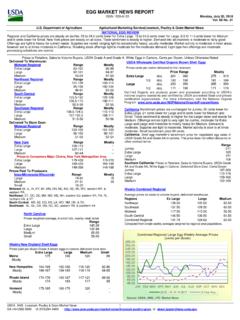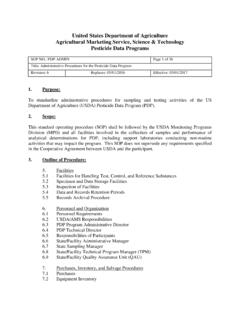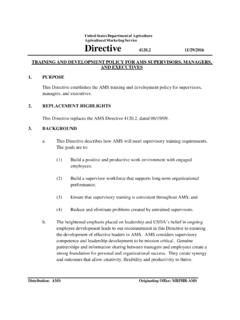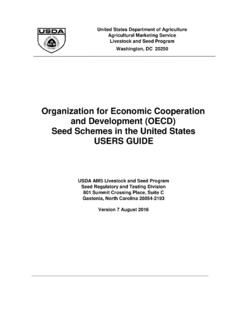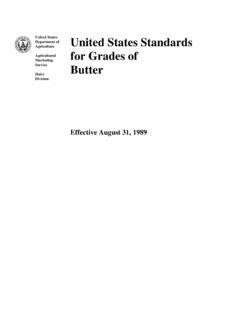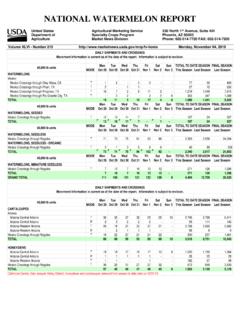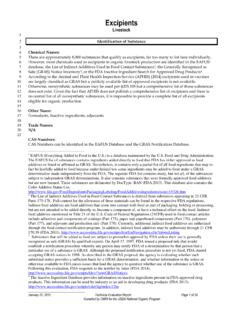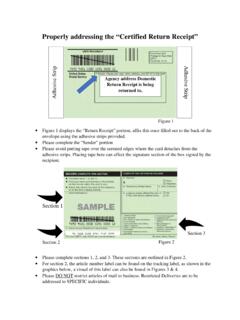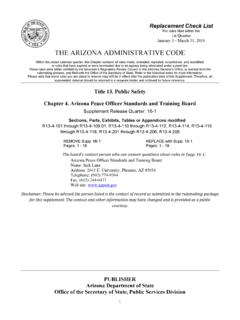Transcription of LABELING ORGANIC PRODUCTS
1 ORGANIC PRODUCTS have strict production and LABELING requirements. Unless noted below, ORGANIC PRODUCTS must meet the following requirements: -Produced without excluded methods ( , genetic engineering), ionizing radiation, or sewage sludge. -Produced per the National List of Allowed and Prohibited Substances (National List). -Overseen by a USDA National ORGANIC Program- authorized certifying agent, following all USDA ORGANIC , if you make a product and want to claim that it or its ingredients are ORGANIC , your final product probably needs to be certified . If you are not certified , you must not make any ORGANIC claim on the principal display panel or use the USDA ORGANIC seal anywhere on the package*.
2 You may only, on the information panel, identify the certified ORGANIC ingredients as ORGANIC and the percentage of ORGANIC ingredients. *Some operations are exempt from certification, including ORGANIC farmers who sell $5,000 or less. overview of LABELING the various categories of ORGANIC PRODUCTS is provided below. PRINCIPAL DISPLAY PANEL: portion of the package most likely to be seen by customers at the time of purchase. INFORMATION PANEL: includes ingredient statement (list of ingredients contained in a product, from highest to lowest percentage of final product) and other product certifying agent will review and approve each of your product labels to ensure compliance.
3 To learn more about LABELING requirements in the USDA ORGANIC regulations, visit PERCENT ORGANICRaw or processed agricultural PRODUCTS in the 100 percent ORGANIC category must meet these criteria: -All ingredients must be certified ORGANIC . -Any processing aids must be ORGANIC . -Product labels must state the name of the certifying agent on the information include USDA ORGANIC seal and/or 100 percent ORGANIC identify ORGANIC ingredients ( , ORGANIC dill) or via asterisk or other or processed agricultural PRODUCTS in the ORGANIC category must meet these criteria: -All agricultural ingredients must be certified ORGANIC , except where specified on National List.
4 -Non- ORGANIC ingredients allowed per National List may be used, up to a combined total of five percent of non- ORGANIC content (excluding salt and water). -Product labels must state the name of the certifying agent on the information panel. May include USDA ORGANIC seal and/or ORGANIC identify ORGANIC ingredients ( , ORGANIC dill) or via asterisk or other ORGANIC PRODUCTSPDPPDP_____Can a product be labeled ORGANIC without being certified ? PDP_____USDA National ORGANIC Program | Agricultural Marketing ServiceOctober 2012 MADE WITH ORGANICM ulti-ingredient agricultural PRODUCTS in the made with category must meet these criteria: -At least 70 percent of the product must be certified ORGANIC ingredients (excluding salt and water).
5 -Any remaining agricultural PRODUCTS are not required to be organically produced but must be produced without excluded methods (see page 1). -Non-agricultural PRODUCTS must be specifically allowed on the National List. -Product labels must state the name of the certifying agent on the information state made with ORGANIC (insert up to three ingredients or ingredient categories). Must not include USDA ORGANIC seal anywhere, represent finished product as ORGANIC , or state made with ORGANIC ingredients. Must identify ORGANIC ingredients ( , ORGANIC dill) or via asterisk or other ORGANIC INGREDIENTSM ulti-ingredient PRODUCTS with less than 70 percent certified ORGANIC content (excluding salt and water) don t need to be certified .
6 Any non- certified product:Must not include USDA ORGANIC seal anywhere or the word ORGANIC on principal display only list certified ORGANIC ingredients as ORGANIC in the ingredient list and the percentage of ORGANIC ingredients. Remaining ingredients are not required to follow the USDA ORGANIC regulations. Based on the label, IF the product contains at least 70 percent certified ORGANIC content (excluding salt and water) AND is overseen by a certifying agent, your muffin mix would qualify for the made with ORGANIC LABELING category. To qualify for the ORGANIC category and use the USDA ORGANIC seal, your blueberries and cinnamon would also need to be certified ORGANIC .
7 ALCOHOL. In addition to the USDA ORGANIC requirements, alcoholic beverages must meet the Alcohol and Tobacco Tax and Trade Bureau (TTB) regulations, including sulfite LABELING requirements. Any use of added sulfites means that the wine is only eligible for the made with LABELING category and may not use the USDA ORGANIC seal. Please note that sulfites may only be added to wine made with ORGANIC grapes; wine labeled as made with other ORGANIC fruit ( , apples) may not contain added sulfites. ORGANIC alcohol labels must be reviewed by an ORGANIC certifying agent and the TTB. Learn more: If the finished product is certified ORGANIC and produced in full compliance with the USDA ORGANIC regulations, the entire product may be labeled ORGANIC and display the USDA ORGANIC all instances of specific fibers in the finished product are certified ORGANIC , the label may claim the specific fibers are ORGANIC and identify the percentage of ORGANIC fibers.
8 * Textiles that meet the Global ORGANIC Textile Standard (GOTS) may be sold as ORGANIC in the **Unless the finished product is certified to the USDA ORGANIC regulations, product labels may not state or imply that the finished product is USDA ORGANIC or use the USDA ORGANIC seal. COSMETICS & PERSONAL CARE PRODUCTS For LABELING guidelines on cosmetics and personal care PRODUCTS , visit ORGANIC PRODUCTS (continued)I m combining ORGANIC and non- ORGANIC ingredients to make blueberry muffin mix. How am I allowed to label it?PDP_____ Made with ORGANIC wheat flour and sugar!Ingredients: ORGANIC enriched wheat flour (wheat flour, niacin, reduced iron, thiamin mononitrate, riboflavin, folic acid), ORGANIC cane sugar, blueberries, baking soda, salt, cream of tartar, by Jane s Foods, ORGANIC By John Doe Certification, s Muffin MixPDP_____
